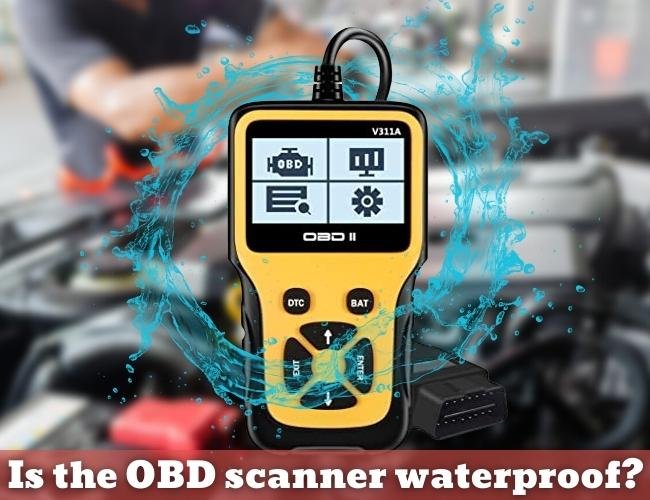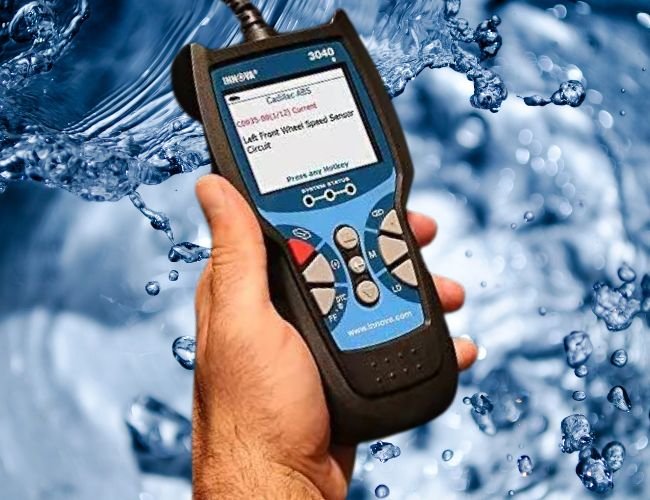Last Updated on June 10, 2025

What is an OBD Scanner?
An OBD scanner (On-Board Diagnostics scanner) is a device that interfaces with your vehicle’s computer system to monitor the health and status of various components. Since the introduction of the OBD-II standard in 1996, nearly every vehicle sold in the United States (and most countries) has an OBD-II port, usually located under the dashboard near the steering column.
With an OBD2 scanner, you can:
- Read engine trouble codes (e.g., P0420, P0300, etc.)
- Reset the check engine light
- Access live data from sensors (O2 sensors, throttle position, fuel trims)
- Monitor emissions readiness
- Conduct advanced diagnostics with professional-grade models
These functions are essential for DIYers, car enthusiasts, and mechanics.
🌧️ Why Weather Resistance Is Becoming Important
Traditionally, scanners were used indoors—in garages or repair shops. But the surge in portable, wireless scanners means more people use these devices:
- At roadside breakdowns
- In parking lots
- Under rainy or humid conditions
- During outdoor inspections
Therefore, understanding whether your OBD scanner is waterproof is more important than ever. One accidental splash or heavy moisture exposure can damage your scanner permanently.
🌦️ Waterproof vs. Water-Resistant
Let’s clarify:
- Waterproof means the device can survive full immersion in water (usually specified by IP ratings like IP67).
- Water-resistant means it can withstand splashes, light rain, or humidity but not full submersion.
Are OBD Scanners Waterproof by Default? (Approx. 500+ words)
🛠️ Are Most OBD Scanners Waterproof?
Unfortunately, the answer is: no, most OBD scanners are not waterproof.
Most consumer-grade OBD2 devices are designed for indoor or dry conditions. Manufacturers often assume:
- You’ll use the device inside the car.
- It will be stored in a toolbox or glove compartment.
- Exposure to water is rare.
This leads to a major oversight—no waterproof protection on standard models.
🧪 The Role of IP Ratings
Some scanners come with IP (Ingress Protection) ratings. For example:
- IP65: Dustproof and protected against water jets.
- IP66/IP67: Can withstand temporary water submersion.
Professional scanners like the Launch X431 V+ or Autel MaxiSys Elite may include such protection, but entry-level models rarely do.
⚙️ Which Components May Be Water-Resistant?
- The cable: Often made of rubber and sealed tightly, the OBD2 cable may survive mild exposure to water.
- Connectors: Some professional-grade connectors have protective seals.
- The body casing: Unless specifically mentioned, plastic scanner bodies are not sealed against water.
💡 Brands Known for Rugged Designs
If you’re looking for something more robust, consider:
- Autel: Advanced waterproof designs in some models.
- Innova: Rugged options with rubberized edges.
- Launch: High-end tablets and scanners with sealed ports and enclosures.
What to Do If Your OBD Scanner Gets Wet (Approx. 450+ words)
Water damage can be devastating—but fast action may save your scanner.
⚠️ Step-by-Step Recovery Process
1. Disconnect Immediately
Unplug the scanner from your vehicle to avoid short circuits or data corruption.
2. Remove Batteries or External Power Sources
If your device uses a battery, remove it to prevent corrosion or fire hazards.
3. Dry Surface Moisture
Use a dry microfiber cloth to wipe the exterior. Be gentle around buttons and screens.
4. Use Isopropyl Alcohol
Dab a small amount of alcohol onto a Q-tip or soft cloth and clean the ports and joints. This helps displace moisture.
5. Leave in Dry Place
Let the device sit for at least 24–48 hours in a warm, dry area. Consider using a sealed bag with silica gel or uncooked rice.
6. Test Before Reuse
Never reconnect a wet device to your car. Instead, test the scanner on a known vehicle, or use its own display to verify that it powers up normally.
🚫 What Not to Do
- Don’t microwave or apply direct heat.
- Don’t plug it into the vehicle while still wet.
- Don’t assume it’s working just because it powers on—run a scan to confirm full functionality.
How to Make Your OBD Scanner Waterproof or Water-Resistant

🧳 Use Waterproof Cases or Bags
Investing in a waterproof case can extend the life of your scanner. These cases are:
- Shock-resistant
- Water-tight
- Designed to protect electronics in harsh conditions
Cost range: $20 to $40
Where to buy: Amazon, eBay, AliExpress, Autel/Innova official sites
🧼 Use Silicone Sealing (Advanced)
Advanced users sometimes seal their device with waterproof silicone around edges and USB ports. This can be risky—only do this if you’re out of warranty and are comfortable modifying electronics.
📲 Opt for Compact Wireless Scanners
Bluetooth OBD2 scanners like the Veepeak BLE, BlueDriver, and FIXD are small, easy to store, and stay inside the car. When paired with your phone, they reduce the need to carry a separate device outdoors.
These are not waterproof but are easier to protect inside weather-sealed containers.
Should You Invest in a Waterproof OBD Scanner?
💰 Is It Worth the Investment?
It depends on your situation.
| Scenario | Waterproof Scanner Needed? |
|---|---|
| DIY user, occasional scans in a garage | ❌ Not necessary |
| Roadside mechanic or mobile technician | ✅ Highly recommended |
| Off-road vehicle maintenance | ✅ Yes, due to mud, rain, and water splashes |
| Urban use only in dry weather | ❌ Use a normal scanner with a case |
🏆 Best Waterproof OBD Scanners to Consider
- Autel MaxiSys Elite – Advanced waterproof body and full bi-directional diagnostics.
- Innova 5610 Pro – Moderately rugged, ideal for mobile techs.
- Launch X431 PRO3S+ – Durable with excellent water protection.
- OTC Encore – Industrial-level protection for shop use.
Final Thoughts: Is the OBD Scanner Waterproof?
So, is the OBD scanner waterproof?
Generally, no, unless it’s a premium-grade model designed for rugged conditions.
For most users, this feature isn’t mandatory—but for professionals, mobile technicians, or users working in wet environments, it can be a deal-breaker.
If your scanner isn’t waterproof, take steps:
- Store it properly
- Use protective cases
- Avoid using it in rain or extreme humidity
Protect your tool—and it will keep protecting your vehicle for years.
FAQs: Is the OBD Scanner Waterproof?
1. Can an OBD scanner get damaged by water?
Yes, most standard OBD scanners are not waterproof and can be damaged if exposed to water. Moisture can short-circuit internal components, corrupt data, or even damage your vehicle’s ECU if a wet scanner is connected. Always dry the device thoroughly before reuse.
2. Are there waterproof OBD scanners available?
Yes, a few professional and rugged models—like the Autel MaxiSys Elite or Launch X431 V+—offer waterproof or water-resistant features. Look for scanners with IP ratings such as IP65 or IP67 to ensure they can withstand exposure to moisture or splashes.
3. What should I do if my OBD2 scanner gets wet?
Immediately disconnect it from your vehicle, open any accessible compartments, dry it with a cloth, and clean the circuit with rubbing alcohol. Let the scanner dry completely for 24–48 hours before testing it again. Never plug in a wet scanner.
4. How can I protect my OBD scanner from water damage?
You can use a waterproof carrying case, a resealable dry bag, or store the scanner in your vehicle’s glove box when not in use. Wireless Bluetooth scanners are also easier to protect and can stay plugged in without exposure to external moisture.
5. Do all professional OBD scanners come waterproof?
No, not all professional scanners are waterproof. However, many high-end models include partial water resistance or rugged housing. Always check the product specifications for IP ratings or weatherproof features before buying.
